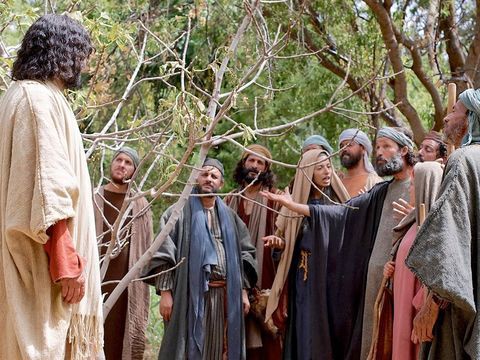 Photo by Aliona Gumeniuk on Unsplash
Photo by Aliona Gumeniuk on Unsplash
Jesus said that he was gentle and lowly of heart. But elsewhere in the gospels, we see Jesus doing some pretty non-gentle things, like supposedly killing fig trees in a rage fit. (Mark 11:12?14) Some skeptics have said this makes Jesus look like a petty punk.
For example, here?s atheist Marshall Brain:
?The son of God is hungry. He approaches a fig tree. The tree is out of season and has no fruit. Jesus wants fruit. So he kills the tree. What a total jerk! Why didn?t he wave his all-powerful hand and cause figs to appear? Or how about borrowing a raisin from someone and turning it into 5,000 baskets of figs? Only a true jerk would kill something out of spite.?
This isn?t the complaint of an unsophisticated atheist here. Even the famous atheist philosopher Bertrand Russell mentions this incident in his essay ?Why I?m Not a Christian?. So was Jesus having a hangry fit here? I?d say the answer is no.
Jesus and Prophetic Theatre
Jesus and his audience knew the writings of the prophets. They would?ve picked up on what Jesus was laying down. The Old Testament prophets used fig trees and vineyards to typify spiritual fruitfulness (or a lack thereof). Just see Isaiah 28:4, Jeremiah 24:1?10, Hosea 9:16?17, Micah 7:1. Let?s read Micah 7:1 to illustrate.
Woe is me! For I have become as when the summer fruit has been gathered, as when the grapes have been gleaned: there is no cluster to eat, no first-ripe fig that my soul desires.
Jesus cursing the fig tree was allegorical of judgment on fruitless Israel. How do we know that? Just look at the story. First, Jesus curses the fig tree. Then he cleanses the Temple, itself a symbolic judgment of the religious leaders. Then the disciples come back and notice the tree is withered. Shortly after that in Mark 12:1?12 and Matthew 21:33?46, Jesus tells the parable of the vineyard.
This parable tells of Israel?s unfaithfulness, their rejection of God?s prophets and ultimately God?s Son, and their impending judgment. Sandwiched between this is the cursing of the fig tree.
Prophetic theatre is nothing new for God?s prophets
Now you might think this is me stretching things, but I?m not. Here are just a few examples of God?s prophets acting strangely to drive home a serious point:
- The prophet Ahijah ripped his clothes in twelve pieces, symbolizing that God was going to tear the kingdom from Solomon and give Jeroboam 10 of the 12 tribes of Israel. (1 Kings 11:29?31)
- Isaiah walked around basically naked for three years to warn the Egyptians and Cushites of impending doom against Assyria. (Isaiah 20:1?6)
- Ezekiel publicly cooked his food over cow poop (!), warning Jerusalem of impending judgment and famine. (Ezekiel 4:1?15)
- And who could forget God commanding Hosea to marry a prostitute as a symbol of Israel?s unfaithfulness? (Hosea 1:2)
Jesus cursing a fig tree is pretty tame in comparison. You might not like that God commanded his prophets to do weird stuff, but extraordinary incoming judgments call for unusual warnings to get people?s attention. God isn?t willing that any should perish and apparently is willing to go to great lengths to shake up the complacent. Just thank God that he hasn?t called you to be a prophet.
Not the season for figs
Why was Jesus looking for fruit when it wasn?t the season? Not only is Jesus a jerk, but he?s apparently also ignorant when figs are ripe. The NIV translates Mark 11:13 to say Jesus went to find out if the tree had ?any fruit?, but the actual Greek word is ?ti?, meaning anything. (Which is how the ESV translates it.) So Jesus was looking for something.
Wikipedia says that there are actually two seasons for figs: ?Two crops of figs can be produced each year. The first or breba crop develops in the spring on last year?s shoot growth. The main fig crop develops on the current year?s shoot growth and ripens in the late summer or fall. The main crop is generally superior in quantity and quality, but some cultivars such as ?Black Mission?, ?Croisic?, and ?Ventura? produce good breba crops.?
The Temple cleansing took place during Passover, which is in Spring. So Jesus expecting to find something on the fig tree isn?t so stupid after all.
But didn?t Jesus use this as an object lesson for faith, not judgment?
When the disciples were amazed that the fig tree quickly withered, Jesus used it as a lesson for teaching that they could have mountain-moving faith. He doesn?t mention judgment. What?s going on with that? In response, here?s theologian Greg Boyd.
? I submit that there is another dimension to the symbolic destructive action of Jesus in this episode. The NT reflects the widespread Jewish apocalyptic expectation that the coming of the Messiah at the end of the age would remove the curse on the creation and restore it to what God originally intended it to be (e.g. Acts 3:21; Rom 8:19?22; Col 1:18?20; 2 Pet 3:13). Moreover, in apocalyptic thought, barren or infected fruit trees were sometimes understood to reflect the corrupting influence of fallen angelic powers, and barren fig trees, in particular, had in some writings become symbols of this curse. In this light, it is easy to interpret Jesus? cursing of the barren fig tree as not only a symbolic pronouncement of judgment on Israel but also as a symbolic judgment on Satan?s curse on the earth. And in cursing the curse, as it were, Jesus was once again presenting himself as the Messiah who had come to vanquish Satan (Heb 2:14; 1 Jn 3:8) and to restore God?s good creation.?
As moderns, we might find this explanation to be strange. Talking to trees is well?odd to say the least. But Jesus also rebuked fevers (Lk 4:39) and storms. (Mk 4:39) Jesus even blamed Satan for diseases on several occasions. (Luke 13:16) He didn?t believe that nature is always operating as God intended and that there was an enemy behind it. He often answered and opposed things that were not operating according to God?s original creational order. That might be weird to us, but it doesn?t mean Jesus was being a jerk here.
 freebibleimages.com
freebibleimages.com
A contradiction in the accounts?
But wait! There are more problems with these passages, according to the critics. Mark places the cursing before the Temple was cleansed. (Mark 11:11?15, 20?25) But Matthew places the cursing of the fig tree after the cleansing of the Temple. (Matthew 21:12?22) Also, in Matthew, the withering appears to take place ?at once? (Matt. 21:19). In Mark, it seems to take place over a whole day. What?s happening here? Aren?t these contradictions?
I don?t think so. Matthew is more of a ?get to the gist? guy and uses a literary device called compression. Compression is where a writer will pack a lot in and be selective when and where to cut bits of information while still giving you the main details.
So for example, Mark takes 20 verses to tell us about the curing of the Gadarene demoniac. Matthew uses less than a third of the amount of space. (Mark 5:1?20, Matt 8:28?34) Mark uses 22 verses to tell us about the healing of the woman with the issue of blood and Jesus raising Jairus? daughter. Matthew uses just 9. (Mark 5:21?43 and Matthew 9:18?26) The stories have some apparent differences partially due to Matthew?s use of compression, but the main details are still there. (I talk more about compression and the alleged differences between when Jairus? daughter died here.)
So with the cursing of the fig tree, Matthew takes up two verses (Matt 21:19?20) for the main event. Mark takes four verses to tell us the story. (Mark 11:13?14, 20?21)
Why Matthew compresses the story
Theologian Vern Poythress gives us some of the logic behind Matthew?s use of compression:
?Mark has made the whole account more complex by separating the two stages of the action into two distinct days, with the cleansing of the temple in between. Matthew, by comparison, gives the whole history of the interaction with the fig tree ?in one blow,? so to speak, and lets us quickly grasp the curse and its consequence. There is clearly something to be gained by this compressed approach. If Matthew takes a compressed approach, it eliminates some contrastive possibilities. With a more extended narrative, such as Mark undertakes, the narrator can choose to make the point that the action took place in two stages over a period of two days. And this extended explanation of the action contrasts in various ways with directly asserting that all the action took place on one day, or depicting the distinct pieces of action with other kinds of extended wording. Matthew, by choosing to compress, loses some of this contrast.? (Inerrancy and the Gospels, p 146)
So there?s nothing really all that fishy going on here. There isn?t a contradiction when we understand the author?s intentions.
When did the fig tree wither?
Matthew says the withering happened ?at once? (Matt. 21:20) Other translations say ?so quickly? or ?how soon?. The Greek word is parachr?ma, which can mean immediately or soon. There are various shades of meaning available. Matthew doesn?t precisely say how long it took. I think we imagine Jesus speaks to the tree and ?boom!?, it?s dead. But Matthew doesn?t provide minute details and we?ve seen from above that?s not his aim.
We simply know that the fig tree withered unusually fast. Maybe the withering took place over a day, between the time when Jesus pronounced the course in the morning before cleansing the Temple (Mark 11:14) and the time when the disciples noticed it the next morning. Or maybe the withering took place within a period of a few moments, right after the disciples moved on from the location of the tree to the Temple (Mk 11:15). We don?t know for sure.
By Matthew shortening the interaction into a brief story, he emphasizes the authority of Jesus, the power of faith and the quickness of the result. Mark divides up the incident, inviting us to see the relationship between the fig tree and the judgment of the Temple that I discussed above.
Jesus Wasn?t Hangry
So when we properly understand what Jesus was doing here, we see that Jesus didn?t need a Snickers break. And the two accounts in Matthew and Mark don?t contradict each other, Matthew is more of a ?get to the bottom line? kind of person, where Mark provides more details. Critics fail to grasp the context of the Old Testament prophets and what Jesus was acting out. And they fail to understand Matthew?s use of a very common literary device.
The issues just aren?t what the skeptics make them out to be.
Originally published at https://isjesusalive.com on March 24, 2020.


